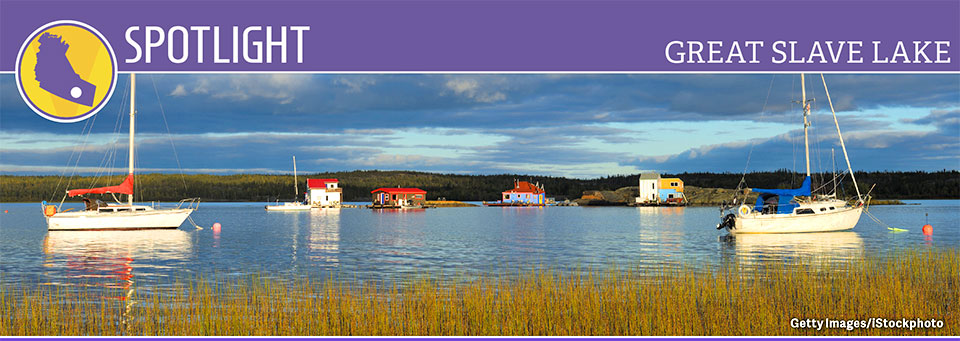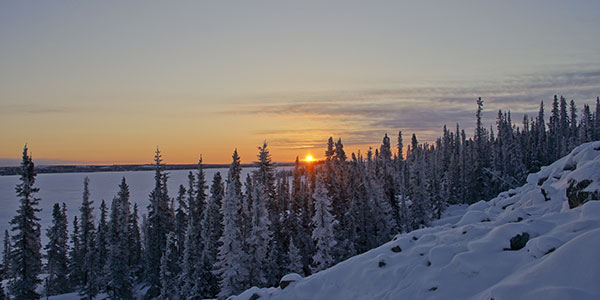

Great Slave Lake
Explore the shore of a vast, watery wilderness

The Great Slave Lake stretches across the Northwest Territories like an inland ocean, an expanse of clear blue water that breaks up the rugged terrain of soft woods and vast tundra. Home to a wide variety of fish, mammals and birds, it’s North America’s fifth-largest lake, with 10,502 square miles of surface area and depths reaching more than 2,000 feet.
Visitors take advantage of the lake’s sheer size for uncrowded fishing and boating adventures during the summer; in the winter, the lake’s frozen surface makes it a perfect setting for dogsledding and cross-country skiing adventures.
Because the Northwest Territory has the second-lowest population density of Canada’s provinces and territories—the prize goes to Nunavut to the east—visitors are guaranteed to avoid big traffic jams or bustling crowds. Travelers can start their Great Slave Lake adventure at the handful of small towns found on its shores. Intrepid explorers can go boating in the lake for seemingly endless exploration.
Wild Past
The lake was named after the Slavey First Nations people, who hunted and fished on the lake’s shore. In 1771, explorer Samuel Hearne discovered the lake, and the region’s population exploded when the area became a stopping point for explorers on their way to the Klondike goldfields in the late 1800s. In the 1930s, the discovery of Gold near Yellowknife brought a new influx of prospectors to the region.
The region’s rough-and-tumble past is evident in the small communities that sit on the shore. A great starting point is Fort Providence, which lies on the Mackenzie River near its outlet into the Great Slave Lake. Local shops sell a wide selection of First Nations arts, crafts and clothing, including handmade anoraks and parkas. Filling stations around town rent boats for lake and river exploration. Standing at the western end of town is a statue of American explorer Sir Alexander Mackenzie, who stopped at Fort Providence during his trek to the Pacific Ocean. To the north of town is the Mackenzie Bison Sanctuary, protecting wood buffalo that were once threatened with extinction. It’s not uncommon to see these majestic mammals standing near the roadside in the evening.
Another stop is Hay River, on the south shore of the lake and at the mouth of the river that shares its name. The town is a magnet for sports fishing, with arctic grayling, lake trout and northern pike enticing anglers from across the world. When your arms get tired from hauling in hefty catches, make a visit to nearby territorial parks, where spectacular scenery awaits. Just 30 miles south of Town, Louise Falls dazzles with its 66-foot tall curtain of water. Equally amazing is nearby Alexandra falls.

A Sharp Town
Revel in the region’s rollicking culture in Yellowknife, sitting on the lake’s North Shore. Once a hub for gold prospectors, this community of nearly 20,000 residents thrives as a hub for outdoor adventure and cultural attractions. Known for its fun and often-quirky local scene, the capital of the Northwest Territories, is an ideal launching point for hunting and hiking adventures to the surrounding wilderness. In the evenings, the spectacular northern lights shimmer overhead. You don’t need to be a gold miner to appreciate the treasures in this corner of Canada.
For More Information
Northwest Territories
800-661-0788